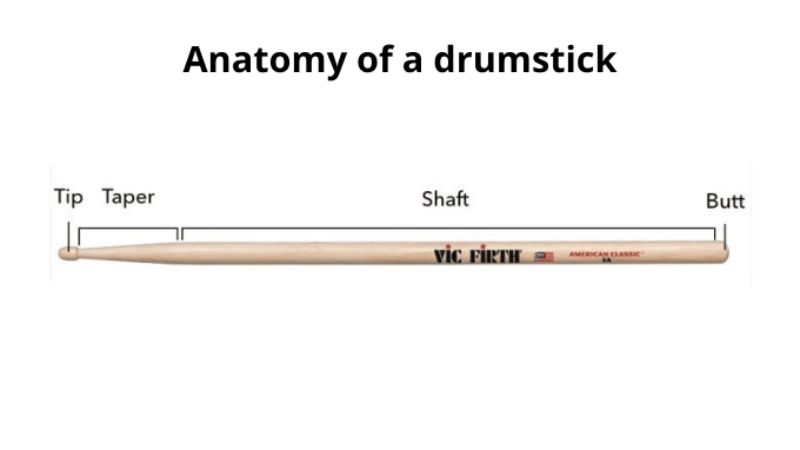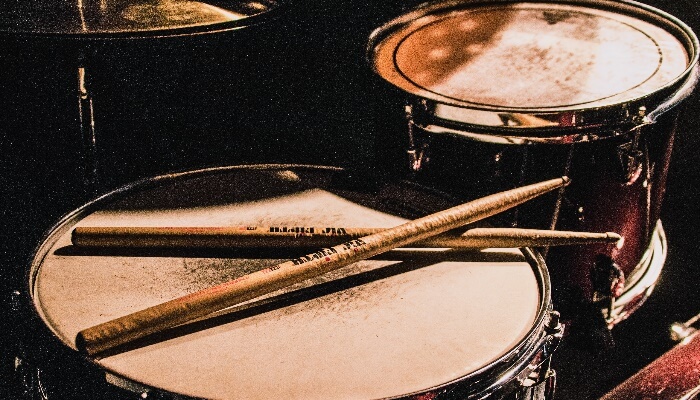Jazz drumming requires precise instrument selection.
The choice of drumsticks impacts sound quality, performance, and player comfort in jazz music.
This comprehensive guide explores drumstick characteristics, brand offerings, and selection criteria for jazz drummers.
We’ll delve into stick anatomy, materials, dimensions, and how these factors influence jazz performance across various subgenres.
By examining top brands, signature models, and expert recommendations, this article aims to provide a thorough understanding of selecting the ideal drumsticks for jazz.
Introduction to Jazz Drumsticks
Jazz drumsticks serve as extensions of the drummer’s musical expression.
These specialized tools enable nuanced performances characteristic of jazz genres.
Drumsticks for jazz differ from those used in other styles due to the genre’s unique demands for dynamics, articulation, and tonal variety.
The Importance of Choosing the Right Drumsticks for Jazz
Proper drumstick selection enhances a jazz drummer’s capabilities.
The right sticks facilitate precise articulation, tonal control, and comfortable play during extended jazz sessions.
Ill-suited drumsticks can hinder performance quality and potentially cause physical strain.
Understanding Drumstick Anatomy
Drumstick anatomy comprises five key components:
- Tip: The striking surface
- Taper: The narrowing section
- Shoulder: The transition between taper and shaft
- Shaft: The main body
- Butt: The rear end
Each component plays a role in stick balance, rebound, and sound production.


Types of Drumsticks for Jazz
Jazz drumsticks come in various materials and tip designs.
Wood remains the predominant material, with hickory, maple, and oak being popular choices.
Synthetic materials offer increased durability but may sacrifice tonal warmth.
Tip shapes include:
- Round: Versatile, balanced tone
- Barrel: Focused sound, excellent for ride cymbals
- Oval: Broader sound, good for toms
- Teardrop: Combines characteristics of round and barrel
Nylon tips produce brighter tones and last longer, while wood tips offer warmer sounds preferred by many jazz traditionalists.
Drumstick Dimensions
Drumstick dimensions significantly influence playing experience and sound production. Key dimensions include:
| Dimension | Impact on Playing |
|---|---|
| Length | Reach and leverage |
| Diameter | Grip comfort and volume control |
| Weight | Speed and power |
Jazz drummers often prefer lighter, thinner sticks for increased speed and finesse, but preferences vary based on individual style and physical attributes.
How Drumstick Characteristics Affect Jazz Performance
Drumstick characteristics directly influence various aspects of jazz performance:
- Sound Quality: Material and tip shape affect tonal characteristics
- Articulation: Tip design impacts clarity and definition of notes
- Control and Speed: Weight and balance affect maneuverability
- Durability: Material choice influences stick longevity
The interplay of these factors determines overall performance quality in jazz drumming contexts.
Traditional Jazz vs. Modern Jazz: Stick Requirements
Traditional jazz and modern jazz demand different approaches to stick selection.
Traditional jazz often requires lighter, more responsive sticks for intricate brush work and subtle dynamics.
Modern jazz may benefit from slightly heavier sticks to accommodate fusion elements and complex rhythms.
| Jazz Style | Preferred Stick Characteristics |
|---|---|
| Traditional | Lighter, thinner, wood tips |
| Modern | Medium weight, versatile, nylon or wood tips |
Factors to Consider When Choosing Jazz Drumsticks
Selecting jazz drumsticks involves considering multiple factors:
- Playing Style: Personal technique and musical approach
- Subgenre of Jazz: Traditional, modern, fusion, etc.
- Drum Set Configuration: Acoustic or hybrid setups
- Personal Preferences: Comfort, feel, and sound preferences
These considerations help narrow down the vast array of options available to jazz drummers.
Top Drumstick Brands for Jazz
Several brands have established reputations for quality jazz drumsticks:
Vic Firth offers a wide range of jazz-specific models, including the popular 7A and 5A sizes.
Their Steve Gadd signature model caters to versatile jazz playing styles.
Vater produces high-quality maple and hickory options favored by many jazz drummers.
Their Sugar Maple series provides lightweight, responsive sticks ideal for intricate jazz work.
ProMark collaborates with jazz legends to create signature models.
Their Shira Kashi Oak sticks deliver exceptional durability and tonal clarity.
Other notable brands include Zildjian, Regal Tip, and Innovative Percussion, each offering unique features catering to jazz drummers’ needs.
Signature Jazz Drumstick Models
Signature models reflect the preferences of renowned jazz drummers.
These sticks often incorporate unique design elements to suit specific playing styles.
For example, the Vic Firth Peter Erskine Ride Stick features an elongated taper for enhanced cymbal work, while the ProMark Mike Clark Jazz Cafe offers a distinctive grip and balance point.
Wood Types Used in Jazz Drumsticks
Wood selection greatly influences stick performance and durability:
- Hickory: Provides excellent durability and shock absorption
- Maple: Offers lightweight responsiveness and warm tones
- Oak: Delivers increased density and projection
Each wood type presents a unique balance of weight, responsiveness, and tonal characteristics, catering to diverse jazz drumming needs.
Nylon vs. Wood Tips for Jazz
The choice between nylon and wood tips depends on tonal preferences and playing requirements.
Nylon tips produce brighter, more articulate sounds and offer increased durability.
Wood tips generate warmer, more traditional tones but may wear faster.
Many jazz drummers prefer wood tips for their organic feel and sound, particularly in acoustic settings.
Drumstick Grips in Jazz
Jazz drumming employs two primary grip styles:
- Traditional Grip: Originated from military drumming, often used in traditional jazz
- Matched Grip: Both hands hold sticks similarly, common in modern jazz and fusion
Grip choice influences stick control, speed, and overall playing technique.
Many jazz drummers become proficient in both grips to adapt to various musical situations.
Balancing Power and Finesse in Jazz Drumming
Jazz drumming requires a delicate balance between power and finesse.
Stick selection plays a crucial role in achieving this balance.
Lighter sticks facilitate quick, intricate patterns and subtle dynamics, while slightly heavier options provide more power for accents and louder passages.
Many jazz drummers opt for a versatile, medium-weight stick that can handle both delicate brush work and more forceful playing when needed.
Drumstick Maintenance and Longevity
Proper maintenance extends drumstick lifespan and ensures consistent performance.
Key maintenance practices include:
- Rotating sticks regularly to distribute wear
- Storing in a cool, dry place to prevent warping
- Using stick bags for protection during transport
- Sanding down minor splinters to prevent further damage
Quality drumsticks can last several months to a year with proper care, depending on playing frequency and style.
Experimenting with Different Drumsticks
Experimentation plays a crucial role in finding ideal jazz drumsticks.
Drummers should try various brands, models, and materials to discover what best suits their playing style and preferences.
Many drum shops offer test kits or allow in-store trials, providing opportunities to compare different sticks before purchasing.
Budget Considerations for Jazz Drumsticks
Drumstick prices vary widely based on brand, material, and design.
While professional-grade sticks may cost more, they often offer superior performance and longevity.
Budget-conscious drummers can find quality options from reputable brands at mid-range price points.
Investing in well-suited sticks can improve playing experience and potentially reduce long-term costs by lasting longer.
Expert Recommendations and Player Testimonials
Professional jazz drummers often share their stick preferences and experiences.
These insights can provide valuable guidance for both beginners and experienced players.
However, it’s important to remember that individual preferences vary greatly, and what works for one drummer may not be ideal for another.
Conclusion: Selecting Your Ideal Jazz Drumsticks
Choosing the right jazz drumsticks involves considering multiple factors and often requires experimentation.
By understanding stick anatomy, materials, and how different characteristics affect sound and performance, drummers can make informed decisions about their equipment.
Remember that personal comfort and playing style should guide stick selection, and don’t hesitate to explore various options to find the perfect match for your jazz drumming needs.
FAQs About Jazz Drumsticks
Q: What size drumstick is best for jazz?
A: Many jazz drummers prefer 7A or 5A sizes for their balance of control and versatility.
Q: How often should I replace my jazz drumsticks?
A: Replacement frequency depends on playing style and stick quality, but typically every few months for regular players.
Q: Can I use the same sticks for different jazz subgenres?
A: While versatile sticks exist, some drummers prefer specific models for traditional jazz versus modern or fusion styles.
Q: Are expensive drumsticks worth the investment for jazz playing?
A: High-quality sticks often offer better performance and durability, potentially providing value over time for serious players.
Q: How do I know if a drumstick is right for me?
A: Comfort, control, and desired sound are key indicators. Experimentation and seeking advice from experienced players can help in the selection process.

